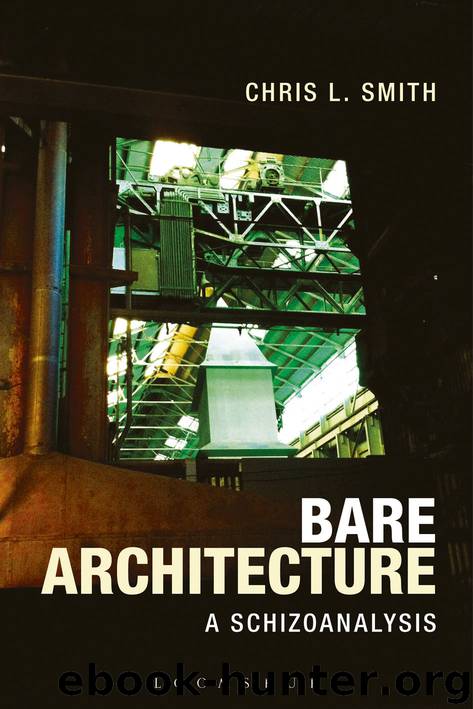Bare Architecture by Chris L. Smith

Author:Chris L. Smith
Language: eng
Format: epub
Publisher: Bloomsbury UK
Published: 2017-11-09T05:00:00+00:00
Symptomatology
Distilling a history for an architecture that posits itself symptomatologically is far more difficult than isolating the therapeutic and diagnostic positioning of architecture. Such an architecture would concern itself neither with uncovering underlying or foundational logical structures nor with posing solutions to commonly stated problems. This is because symptomatology is at once more concrete-real and more abstract-real. It is concrete-real in its attention to the actualities of material existence and the temporality of events. It is abstract-real in that any attention paid to the concrete-reality of the world necessarily involves an indulgence in the rich complexities, intensities and contingencies of life. An architecture posited as symptomatology might engage with the immediacy of the present by exploring and experimenting within the world and its ‘symptoms’. This architecture would express new ways of thinking about life and experiment with novel ways of living. Such an architecture might operate not as a backdrop or stage-set to life but rather would be implicated in life itself; in a manner that resonates with what Roland Barthes describes as ‘theatricalization’.
In his book Sade, Fourier, Loyola (1971) Barthes suggests that theatricalization is not simply ‘designing a setting for representation, but unlimiting the language’.19 When he turns to the literary work of the Marquis de Sade, Barthes exchanges the word ‘writer’ for the word ‘formulator’ and he suggests that Sade ‘always sides with semiosis rather than mimesis’.20 That is, for Barthes, Sade is not an author who refers to things, who answers questions or represents events or situations, but rather Sade constitutes a new world of elaborate spaces and machines and populates that world with a new people – for new and intense acts of sex and violence. In this way Sade is a symptomatologist.
The medical condition sadomasochism, defined by Richard von Krafft-Ebing some 55 years after the death of Sade, but during the lifetime of the writer Baron von Sacher Masoch (from which the term ‘masochism’ is drawn) is a key example engaged by Deleuze to explore the connection of the critical (in a literary sense) and the clinical (in a medical sense). In Deleuze’s extended essay ‘Coldness and Cruelty’ (1989) he turns to the ‘differential mechanisms’ of literature and medicine in the construction of the medicalized condition of ‘sadomasochism’. There is a very tight logic to the essay.21 The clinical aspect of Deleuze’s argument in ‘Coldness and Cruelty’ is explicit: it is foremost a critique of Sigmund Freud’s formulation of sadomasochism and the reiterated aim of the essay is to establish ‘irreducible causal chains’ for sadism and masochism (as separate mechanisms).22 Deleuze’s argument is that the relationship between sadism and masochism is one of analogy only and that ‘in place of a dialectic which all too readily perceives the link between opposites, we should aim for a critical and clinical appraisal able to reveal the truly differential mechanisms’.23 This impulse to isolate causes is not, however, one that pervades ‘Coldness and Cruelty’ where ‘the clinical specification of sadism and masochism are not separable from the literary values particular to Sade and Masoch’.
Download
This site does not store any files on its server. We only index and link to content provided by other sites. Please contact the content providers to delete copyright contents if any and email us, we'll remove relevant links or contents immediately.
Aircraft Design of WWII: A Sketchbook by Lockheed Aircraft Corporation(32140)
The Great Music City by Andrea Baker(30809)
Call Me by Your Name by André Aciman(19943)
The Art of Boudoir Photography: How to Create Stunning Photographs of Women by Christa Meola(18415)
The Secret History by Donna Tartt(18237)
Shoot Sexy by Ryan Armbrust(17565)
Plagued by Fire by Paul Hendrickson(17119)
Portrait Mastery in Black & White: Learn the Signature Style of a Legendary Photographer by Tim Kelly(16878)
Adobe Camera Raw For Digital Photographers Only by Rob Sheppard(16806)
Photographically Speaking: A Deeper Look at Creating Stronger Images (Eva Spring's Library) by David duChemin(16508)
Ready Player One by Cline Ernest(14036)
Pimp by Iceberg Slim(13809)
Bombshells: Glamour Girls of a Lifetime by Sullivan Steve(13706)
The Goal (Off-Campus #4) by Elle Kennedy(13213)
Art Nude Photography Explained: How to Photograph and Understand Great Art Nude Images by Simon Walden(12859)
Kathy Andrews Collection by Kathy Andrews(11346)
The Priory of the Orange Tree by Samantha Shannon(8646)
Thirteen Reasons Why by Jay Asher(8477)
The remains of the day by Kazuo Ishiguro(8419)
